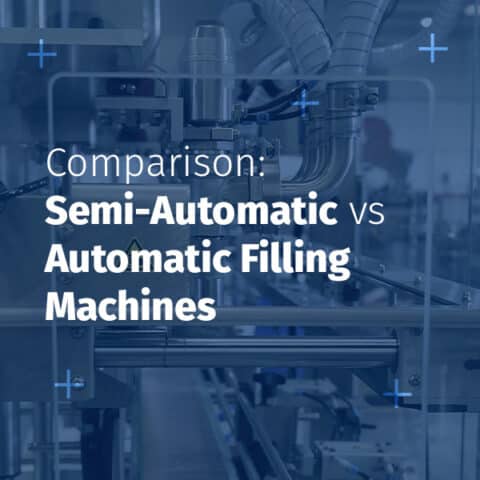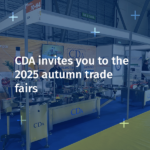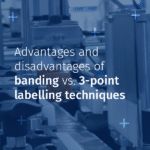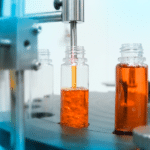Choosing the right dosing machine can be a complex decision. Whether you are a manufacturer in the food, cosmetics, chemical or pharmaceutical industry, the way you fill your containers can have an impact on your productivity and the consistency of your packaging.
At CDA, we offer a wide range of semi-automatic and automatic filling machines that can be adapted to many different products (liquids, viscous, pasty, dense) and containers (bottles, jars, pots, buckets, cans, etc.).
We have therefore decided to create a comparison to analyse the differences between semi-automatic and automatic filling machines: advantages, limitations, costs, productivity, etc., to help you choose the solution that best suits your needs.
What is a Semi-Automatic Filling Machine?
A semi-automatic filler requires operator involvement to initiate or assist the filling cycle, while the dosing operation itself is automated. The operator positions the container under the filling nozzle, activates the control (via pedal, button or sensor), and the machine dispenses the programmed volume. Once the container is filled, the operator removes it manually.
Advantages of Semi-Automatic Filling Machines
Semi-automatic filling machines are highly advantageous for small and medium producers. They require a lower investment, provide accurate and hygienic dosing, and are easy to operate with minimal training. Compact and mobile, they fit easily into workshops with limited space.
Limitations
Their production rate depends on the operator, usually ranging between 400 and 800 containers per hour. Continuous human supervision is required, making them less suited to large-scale production or high-demand environments.
Typical Uses
A semi-automatic filler is perfect for small producers such as organic juice brands selling locally, start-up cosmetics manufacturers, SMEs launching new products, or premium brands producing in limited batches.
What is an Automatic Filling Machine?
An automatic filling machine operates independently, often integrated into a complete packaging line. It automatically positions the containers via a conveyor, fills them without manual intervention and transfers them to the next stage, such as capping or labelling.
Advantages
Automatic filling machines provide high production speeds, typically between 1,000 and 3,000 containers per hour depending on the model. They ensure consistent dosing, eliminate human error and significantly improve working conditions since operators supervise rather than handle containers. They can also be seamlessly integrated with cappers, crimpers and labellers to create a fully automated line.
Limitations
Automatic systems require a higher initial investment and more floor space. Operators also need to be trained to use and adjust advanced settings. However, once set up, they deliver consistent, reliable performance that easily meets industrial production demands.
Typical Uses
Automatic fillers are commonly used in the food industry for large-scale bottling, in cosmetics laboratories handling multiple ranges, and in chemical manufacturing where precision, safety and speed are essential.
How to Choose Between Semi-Automatic and Automatic?
To make the right choice, consider your production volume now and in the next few years, the texture of your products, the types of containers you use, your need for flexibility and your available budget.
For artisans or small producers, a semi-automatic filler such as the K-One or K-Net is ideal to start production and maintain flexibility.
For growing SMEs, a compact automatic filler or a progressive packaging line offers a balanced step forward.
For large industries, a high-performance model like the K-Line S provides the speed, precision and reliability required for continuous production.
Choosing between a semi-automatic and an automatic filling machine depends on your production capacity, product type and growth ambitions.
A semi-automatic filler is the perfect choice to begin operations, test markets and maintain flexibility while controlling investment costs.
An automatic filling machine, on the other hand, is the natural progression for businesses seeking to increase output, consistency and efficiency.
At CDA, we offer solutions for every scale of production, from small craft producers to industrial manufacturers. Whether you choose the K-One for small runs, the K-Dense for viscous products or the K-Line S for industrial filling, our experts are here to help you design the ideal packaging line for your business.
FAQ
What is the difference between a semi-automatic and an automatic filler?
A semi-automatic filler requires operator input, while an automatic filler works autonomously and handles higher production volumes.
Can I start with a semi-automatic and later upgrade to automatic?
Yes. This is the most common and cost-effective progression for small businesses and SMEs.
What is the price difference between semi-automatic and automatic fillers?
Semi-automatic fillers start at a few thousand euros, while automatic systems can cost several tens or even hundreds of thousands depending on configuration and capacity.
What products can be filled with the K-Dense?
Honey, jam, sauces, creams, gels and hygiene products.
Which industries use CDA filling machines?
Food, cosmetics, chemicals, pharmaceuticals, e-liquids, essential oils and many more.











